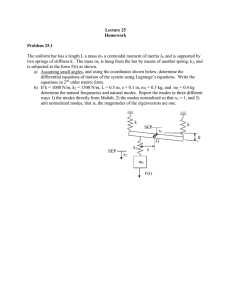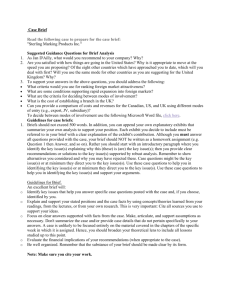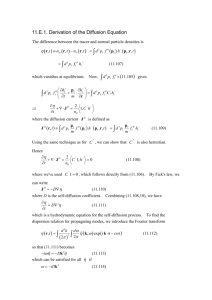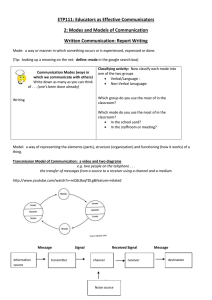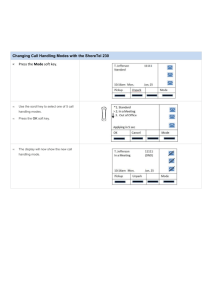Learning Restricted Boltzmann Machines using Mode-Hopping MCMC Yang Hu and Yong Yu
advertisement
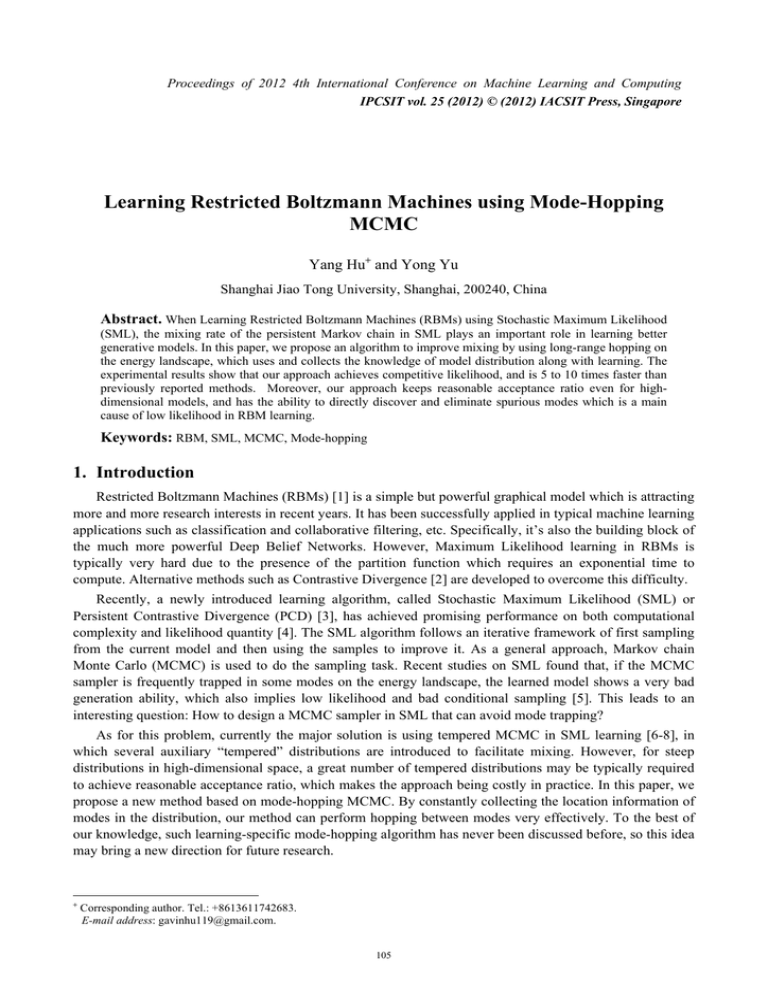
Proceedings of 2012 4th International Conference on Machine Learning and Computing
IPCSIT vol. 25 (2012) © (2012) IACSIT Press, Singapore
Learning Restricted Boltzmann Machines using Mode-Hopping
MCMC
Yang Hu+ and Yong Yu
Shanghai Jiao Tong University, Shanghai, 200240, China
Abstract. When Learning Restricted Boltzmann Machines (RBMs) using Stochastic Maximum Likelihood
(SML), the mixing rate of the persistent Markov chain in SML plays an important role in learning better
generative models. In this paper, we propose an algorithm to improve mixing by using long-range hopping on
the energy landscape, which uses and collects the knowledge of model distribution along with learning. The
experimental results show that our approach achieves competitive likelihood, and is 5 to 10 times faster than
previously reported methods. Moreover, our approach keeps reasonable acceptance ratio even for highdimensional models, and has the ability to directly discover and eliminate spurious modes which is a main
cause of low likelihood in RBM learning.
Keywords: RBM, SML, MCMC, Mode-hopping
1. Introduction
Restricted Boltzmann Machines (RBMs) [1] is a simple but powerful graphical model which is attracting
more and more research interests in recent years. It has been successfully applied in typical machine learning
applications such as classification and collaborative filtering, etc. Specifically, it’s also the building block of
the much more powerful Deep Belief Networks. However, Maximum Likelihood learning in RBMs is
typically very hard due to the presence of the partition function which requires an exponential time to
compute. Alternative methods such as Contrastive Divergence [2] are developed to overcome this difficulty.
Recently, a newly introduced learning algorithm, called Stochastic Maximum Likelihood (SML) or
Persistent Contrastive Divergence (PCD) [3], has achieved promising performance on both computational
complexity and likelihood quantity [4]. The SML algorithm follows an iterative framework of first sampling
from the current model and then using the samples to improve it. As a general approach, Markov chain
Monte Carlo (MCMC) is used to do the sampling task. Recent studies on SML found that, if the MCMC
sampler is frequently trapped in some modes on the energy landscape, the learned model shows a very bad
generation ability, which also implies low likelihood and bad conditional sampling [5]. This leads to an
interesting question: How to design a MCMC sampler in SML that can avoid mode trapping?
As for this problem, currently the major solution is using tempered MCMC in SML learning [6-8], in
which several auxiliary “tempered” distributions are introduced to facilitate mixing. However, for steep
distributions in high-dimensional space, a great number of tempered distributions may be typically required
to achieve reasonable acceptance ratio, which makes the approach being costly in practice. In this paper, we
propose a new method based on mode-hopping MCMC. By constantly collecting the location information of
modes in the distribution, our method can perform hopping between modes very effectively. To the best of
our knowledge, such learning-specific mode-hopping algorithm has never been discussed before, so this idea
may bring a new direction for future research.
+
Corresponding author. Tel.: +8613611742683.
E-mail address: gavinhu119@gmail.com.
105
2. Restricted Boltzmann Machines
Restricted Boltzmann Machines (RBMs) is a specific graphic model which has a bipartite structure. It
contains two types of unit: visible and hidden, each resides in a layer. Visible units are used to represent the
data, and hidden units are used to represent latent factors. We often use v to denote the state vector of the
visible units, and h to denote the state vector of the hidden units. The state of units can either be continuous,
discrete or binary [x]. In this paper, we focus on binary case for both layers.
For an RBM containing v visible units and h hidden units, let vi denotes the state of the i -th visible
unit, and h j denotes the state of the j -th hidden unit. Then for a given state v, h , the energy of the RBM is
defined as
v
h
v
h
i =1
j =1
E (v, h) = −∑∑ viWij h j − ∑ vi bi − ∑ h j c j
i =1 j =1
(1)
where Wij , bi , c j are model parameters. The probability of state v, h is
P (v, h ) =
1
exp(− E (v, h)), Z = ∑ exp(− E (v, h))
Z
v,h
(2)
3. Stochastic Maximum Likelihood Learning for RBMs
To learn an RBM, we are given a dataset D = {v (1) , v ( 2 ) ,..., v ( d ) } , and the learning objective is to
maximize the log-likelihood function as follows
d
d
k =1
k =1
L = ∑ log P (v ( k ) ) ≡ ∑ log ∑ P (v ( k ) , h)
(3)
h
In Stochastic Maximum Likelihood learning, we follow the gradient ascending procedure. For each
iteration, we compute the gradient as (for length limitation we omitted the bias parameters bi , c j )
1 d
∂L
∝ ∑ vi( k ) P (h j | v ( k ) ) − vi h j
∂Wij d k =1
P (v,h)
(4)
.
where
P ( v ,h ) denotes an expectation under the current model distribution, which cannot be precisely
computed in a reasonable time. To quickly approximate this term, in SML, a MCMC sampler is introduced
to take samples from the distribution. Since the state of the Markov chain is not reset after the model is
updated, the Markov chain is also referred to as a Persistent Markov Chain [3].
4. Mode-Hopping in SML
Intuitively, a mode is a deep well on the energy landscape such that a MCMC sampler based on local
transition can hardly move out when it enters in. From this point of view, a mode can usually be represented
by the state with minimal energy in its well, we refer to such state as a mode state. To locate modes, we
introduce a deterministic function μ ( x) that returns a nearby mode state of x , which is usually implemented
with a local optimization algorithm.
Throughout this paper, we use a mode set L = {mi : mi = μ (mi ), i = 1,2,3,...} to keep the knowledge of
mode locations required in our algorithm, in which each mode i is represented by the inner mode state mi .
Let L denotes the number of modes in L . In practice, L can be huge and we can't keep all the modes, thus
we restrict the size of L under a predefined upperbound K. This leads to a problem of how to select modes
into L , which will be discussed in section 4.2.
4.1. Proposing Mode-Hoppings in RBMs
Due to RBMs' bipartite structure, we can perform mode-hopping in marginal distribution of either v or
h rather than in their joint distribution. In particular, consider a transition kernel T (v,.) for the visible states.
106
Suppose the current state is (v, h) , to propose a new state, we can first propose a new v using T (v,.) ,
followed by a new h using the Gibbs transition P(. | v) . Let (v' , h' ) denotes the new state, then according
to the Metropolis-Hastings rule, the acceptance probability of which is
⎧ P(v' , h' )T (v' , v) P(h | v) ⎫
⎧ P(v' )T (v' , v) ⎫
r ((v, h) → (v' , h' )) = min ⎨1,
⎬ = min ⎨1,
⎬
⎩ P(v, h)T (v, v' ) P(h'| v' ) ⎭
⎩ P(v)T (v, v' ) ⎭
(5)
To propose a mode-hopping in marginal distribution P (v) , we introduce the following transition kernels:
g (v, i) , moving from state v to a nearby mode i ( 1 ≤ i ≤ L ).
z H (i, j ) , hopping from mode i to j ( 1 ≤ i, j ≤ L , i ≠ j ).
z g (i, v) , proposing a state v via mode i ( 1 ≤ i ≤ L ).
where i, j denote mode indices in L . The mode-hopping from state v can be performed as follows: first
move to a nearby mode i , next perform a hopping from i to j , then propose a new state v' via mode j ,
finally accept v' with probability
z
⎧ P(v' ) g (u, j ) H ( j , i ) g (i, v) ⎫
r (v, v' ) = min ⎨1,
⎬
⎩ P(v) g (v, i) H (i, j ) g ( j , u ) ⎭
(6)
To implement g (i,.) in RBMs, we first compute h that maximize P (h | mi ) , then we draw v ~ P(. | h) .
For g (v, i ) , assume we have a mixture distribution with each g (i,.) as a component, we can take g (v, i ) as
the a posteriori probability of component i under the observation of v . According to Bayes rule, we have
g (i, v) p(i )
≡
(7)
L
L ∑ j =1 p(v | j ) p( j ) ∑ j =1 g ( j, v) p( j )
L We can simply set p (i ) = 1 / L for each i , which yields g (v, i ) = g (i, v ) / ∑ j =1 g ( j , v) .
Consider the mode-hopping probability, H (i, j ) . If we can estimate the weight wij associated with
hopping from mode i to mode j , then H (i, j ) can be defined as H (i, j ) = wij / ∑ k ≠ i wik .
We propose three general strategies for estimating the weights: 1. wij = 1 for all i, j , where hopping to
any other mode is uniformly chosen; 2. wij ∝ P (m j ) where a hopping to the mode with lowers energy is
preferred; 3. wij ∝ mi − m j where . denotes a distance measure, in this case a hopping with longer
g (v, i ) ≡ p(i | v) =
p(v | i ) p(i )
distance is preferred.
4.2. Maintaining the Mode Set
Using prior location information of the modes to facilitate mode-hopping is not a new idea [9]. In AIN
Ibrahim's method [10], an initial exploration on the energy landscape is performed to locate modes before
sampling. However, this approach can't be applied in learning directly, since (1) the energy landscape is
almost flat before learning and we can't find any useful mode; (2) the energy landscape is changing during
learning and the modes information may be out of date. Using training data to locate modes, as proposed in
[11], could be a feasible solution since those modes are always valid with the model being correctly learned.
But this approach cannot handle any spurious mode, which is occasionally learned and will hurt the SML
learning if it's not eliminated in the end.
Rather than keeping a static modes information, our method starts with L = {} , then dynamically collects
and adds modes into L along with learning. We use search algorithms to locate modes as AIN Ibrahim did.
However, instead of performing an initial exploration, we rebuild L periodically to keep it up-to-date as the
model changes.
In particular, since the size of L is limited by K, we define a total order for the mode states to determine
which modes should be selected into L . We simply use the probability of mode states to rank the modes, and
dynamically find and add modes into L . If the size of L exceeds its capacity K, we just drop the modes with
lowest probabilities in L to guarantee that we always have L ≤ K . Besides, a predefined radius R is also
introduced to prevent modes in L from aggregating by assuring that every two mode states mi , m j in L
107
have a hamming distance greater than or equal to R. If two states in L violate this restriction, we drop the
one with lower probability. To find modes, in this work, we first use a random walk to pick a non-mode state
v , then we use a local optimization μ (v) to locate its nearby mode state.
-100
Maximum Log-Likelihood
Training Data Log-Likelihood
0
-150
-200
SML-10
AMH-0.1
PT-10
-250
0
5
10
15
-50
-104.184
-150
20
-82.96 -79.249
-100
-74.484
-69.6
-94.744
SML-1 SML-10
PT-5
PT-10 AMH-0.1 AMH-1
Number of Parameter Updates (*5000)
Methods
(a)
(b)
Fig. 1: a) Log-likelihood of training data under a model trained with SML-10, AMH-0.1 and PT-10. b) The maximum
log-likelihood obtained with 100,000 updates for various algorithms.
Both SML-n and PT-n are approximately n times slower than SML-1. Besides, in our implementation, AMH-0.1 is just
slightly slower than SML-1, and AMH-1 is 2 or 3 times slower than SML-1.
5. Experimental Results
In this section, we conduct various experiments on the familiar MNIST handwritten dataset to validate
our algorithm. We first compare our algorithm with previous methods, and test its scalability on RBMs with
various dimensionalities, and then we show visually that our algorithm can find spurious modes during
learning.
5.1. Toy Experiments on the Log-Likelihood
We first conduct a series of toy experiments, in which we select 10 datavectors of digits 0 to 9 from
MNIST to learn a small RBM with 10 hidden units, thus we can compute the exact log-likelihood of the
model. In this setting we have 10 modes in total while the marginal distribution of h contains 210 = 1024
different states. Since the number of states are much more than modes we believe there are many high energy
states that may form barriers blocking the transition between certain modes, which can cause trouble for
samplers.
For comparison, we train the model using different methods including SML, tempered SML and our
mode-hopping SML. For tempered SML, we choose Parallel Tempering [8] as a representative since its
parameters are relatively easy to handle. We use SML-n to denote regular SML learning with n Gibbs
updates per parameter change, PT-n to denote Parallel Tempering SML with n tempered chains, and AMH-p
to denote our method with a probability p of proposing a mode-hopping in each learning iteration. For PT
and AMH, we always perform 1 Gibbs update per learning iteration, and the inverse temperatures of PT are
spaced uniformly between 1 and 0.9. In the toy experiments, we set K to 10 and R to 80. We run each
algorithm for 10 times and summarize their performance by their average log-likelihood and corresponding
standard deviation (Fig. 1).
5.2. On the Acceptance Ratio
In our toy experiments, AMH shows an excellent performance. Because of the tiny dimensionality of the
model and the small number of modes, the distribution won't be very steep, and AMH can always keep a
reasonable acceptance ratio. Next we consider using more data to train higher dimensional models.
108
We take the first 10,000 datavectors from MNIST as training data. Fig. 2 shows the evolving of
acceptance ratio as learning proceeds when h is set to various dimensionalities. Clearly, without using mode
set, the acceptance ratio drops rapidly as the dimensionality raises (Fig. 2a). In our method (Fig. 2b), the
acceptance ratio always stays in a reasonable range regardless of high dimensionality, and it does not drop
drastically along with learning. Moreover, we can collect more modes in L by increasing K and decreasing
R, which will provide more comprehensive information about the mode location. This can further improve
the acceptance ratio of mode-hopping as shown in Fig. 2c.
0.35
|h|=15
0.3
|h|=20
0.4
Baseline
(no mode set)
|h|=50
0.25
0.2
0.15
0.4
|h|=10
K=|h|, R=80
0.35
|h|=100
0.35
0.3
|h|=500
0.3
Acceptance Ratio
|h|=10
Acceptance Ratio
Acceptance Ratio
0.4
0.25
0.2
0.15
0.15
0.1
0.05
0.05
0.05
10
20
30
40
Parameter Updates (*1000)
50
0
0
10
20
30
40
Parameter Updates (*1000)
50
|h|=500
0.2
0.1
0
|h|=100
0.25
0.1
0
0
0
10
20
30
40
Parameter Updates (*1000)
(b)
(a)
|h|=10
K=2|h|, R=40
(c)
Fig. 2: Acceptance ratio along with learning: a) Baseline; b) K = h , R = 80; c) K = 2 h , R = 40.
Our baseline is a random walk in the marginal distribution of h without using mode set.
5.3. On the Mode Set
Fig. 3 demonstrates some modes collected when learning an RBM with 500 hidden units. It is clear that
there are many spurious modes beside the ones close to the training data, which will reduce the likelihood of
the model. Our method successfully locates such modes and raises the chance to eliminate them by learning.
At this point, our method is much better than other methods based on static mode information [11].
Fig. 3: Some modes collected when learning an RBM with 500 hidden units.
6. Conclusion
In this paper, a novel RBM learning algorithm of SML type is presented, in which we use the
dynamically maintained location information of the modes to improve the mixing of the persistent chain.
Since we don’t use any intermediate distribution, and the mode location information can be incrementally
updated during learning, our method is much more effective than the previous tempered methods. We test
the algorithm under RBMs with various dimensionalities, indeed, it achieves superior performance at a
relatively cheap computational cost.
7. References
[1] P Smolensky. Information processing in dynamical systems: Foundations of harmony theory. D. E. Rumelhart and
J. L. McClelland (Eds.), Parallel distributed processing, 1:194–281, 1986.
[2] Geoffrey Hinton. Training products of experts by minimizing contrastive divergence. Neural Computation, 4:1771–
1800, 2000.
[3] Tijmen Tieleman. Training restricted boltzmann machines using approximations to the likelihood gradient. In
Proceedings of the 25th international conference on Machine learning, pages 1064–1071, 2008.
109
50
[4] Benjamin M. Marlin, Kevin Swersky, Bo Chen, and O De Freitas. Inductive principles for restricted boltzmann
machine learning. In Proceedings of the Thirteenth International Conference on Artificial Intelligence and Statistics,
2010
[5] Tijmen Tieleman and Geoffrey Hinton. Using fast weights to improve persistent contrastive divergence. In
Proceedings of the 26th International Conference on Machine Learning, pages 1033–1040, 2009.
[6] Ruslan Salakhutdinov. Learning in markov random fields using tempered transitions. In Advances in Neural
Information Processing Systems, 2010.
[7] Ruslan Salakhutdinov. Learning deep boltzmann machines using adaptive mcmc. In Proceedings of the 27th
International Conference on Machine Learning, 2010.
[8] G. Desjardins, A. Courville, Y. Bengio, P. Vincent, and O. Delalleau. Tempered markov chain monte carlo for
training of restricted boltzmann machine. In Proceedings of AISTATS, pages 145–152, 2010
[9] C. Sminchisescu, M. Welling, and G. Hinton. A mode-hopping mcmc sampler. Technical report, University of
Toronto, 2003
[10] AIN Ibrahim. New Methods for Mode Jumping in Markov Chain Monte Carlo Algorithms. PhD thesis, University
of Bath, 2009.
[11] Geoffrey Hinton and Max Welling. Wormholes improve contrastive divergence. In Advances in Neural
Information Processing Systems, 2003
110
